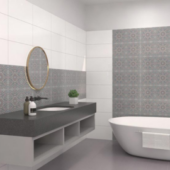Granite, an igneous rock that has embellished the earth’s crust for millions of years, is not just a cornerstone in the construction and design world but also a repository of fascinating secrets. Beyond its renowned durability and timeless elegance, granite harbours a trove of intriguing facts that remain largely unknown to the average observer. This exploration delves into the depths of granite’s essence, unveiling facts that illuminate its unique nature and the amazing stories it holds within its granular composition.
The Geological Marvel
Granite is formed from the slow crystallization of molten magma deep beneath the earth’s surface, a process that can take millions of years. This slow journey from liquid fire to solid stone endows granite with its renowned strength and varied patterns. The unique colors and patterns found in granite are a result of the varied minerals within the magma, such as quartz, feldspar, and mica, which also contribute to its remarkable hardness. This makes granite one of the most durable natural stones, resistant to scratches, heat, and every day wear and tear, a fact that has made it a favourite for countertops and buildings throughout history.
A Palette of History
Each slab of granite is like a historical canvas, telling a story that dates back billions of years. The mineral composition in granite not only contributes to its color and pattern but also embeds a geological narrative of the earth’s developmental history. Some granites, known as ‘heritage stones,’ have been quarried for centuries and are part of human history, contributing to the construction of ancient monuments and modern marvels alike. This aspect of granite offers a direct link to the past, connecting us to the ancient world through our countertops, buildings, and monuments.
Radioactive Revelations
Surprisingly, all granite contains a certain amount of naturally occurring radioactive elements like uranium, thorium, and potassium. These elements decay over time, releasing radon gas, a colorless and odourless gas that can accumulate indoors. However, the levels of radon in granite are generally very low and not considered harmful to human health, according to numerous studies. This fact, often unknown, adds an intriguing dimension to the stone’s character, blending the beauty of nature with the complexities of science.
The Architectural Chameleon
Granite’s versatility in design is unparalleled. It can be polished to a high sheen, honed to a soft matte, or flamed to expose a rough texture, making it adaptable to various architectural and design styles. This chameleonic quality allows granite to fit seamlessly into any décor theme, from ultra-modern to rustic traditional, showcasing its natural beauty in every setting. Its ability to withstand the elements also makes it an ideal choice for outdoor applications, enduring through seasons and time.
Sustainability and Eco-Friendliness
In today’s environmentally conscious world, granite stands out as a sustainable and eco-friendly material. Being a natural stone, it doesn’t require energy-intensive manufacturing processes, and its long-lasting nature means that it doesn’t need to be replaced often, reducing waste. Furthermore, old granite structures and scraps can be repurposed or recycled, minimizing environmental impact and promoting a cycle of sustainability that few other materials can boast.
A Global Tapestry
Granite quarries are scattered across the globe, from the exotic lands of Brazil to the historic quarries of India, and each region imparts its signature touch to the granite it produces. This global diversity is reflected in the vast array of colors, patterns, and qualities available in the market, turning each granite piece into a representation of its homeland. This not only adds a unique aesthetic appeal to the stone but also allows it to carry a piece of global history and culture.
Beyond the Kitchen Counter
While commonly known for its use in kitchen countertops and monuments, granite’s applications are far more extensive. Its resistance to abrasion makes it suitable for high-traffic areas like floors in commercial buildings and public spaces. Artists and sculptors also cherish granite for its durability and the glossy finish it can achieve, making it a popular choice for sculptures and memorials that stand the test of time, weathering the elements with grace and stability.
The Economic Landscape
Granite not only beautifies spaces but also contributes significantly to the economic landscape of the regions where it’s quarried. It provides employment, supports local communities, and plays a pivotal role in the global trade of natural stone. The industry’s commitment to responsible quarrying practices ensures that this economic benefit is balanced with environmental stewardship, preserving the beauty and integrity of the natural world.
Conclusion
Granite is more than just a stone; it is a confluence of history, geology, art, and design. Its extensive palette of colors, enduring nature, and versatile applications make it a perennial favorite in the world of architecture and design. However, the lesser-known facts about granite add layers of intrigue and depth to this natural wonder, elevating it from a mere material to a storyteller, whispering the ancient secrets of the earth. As we continue to unearth the hidden facets of granite, we not only gain insight into the stone itself but also develop a deeper appreciation for the natural world and its complex beauty.
Visit our showroom today at 134, Opp. Forest Park, Nr. Yadav Petrol Pump, Pune-Nagar Road, or contact us at 8888843560. Explore the diverse range of floor tiles available at Chandan Marbles, and let our experts guide you in selecting the perfect tiles for your home. Additionally, you can browse our offerings on our website at www.chandanmarbles.com. Elevate your interior design with the timeless beauty and durability of our premium floor tiles.






